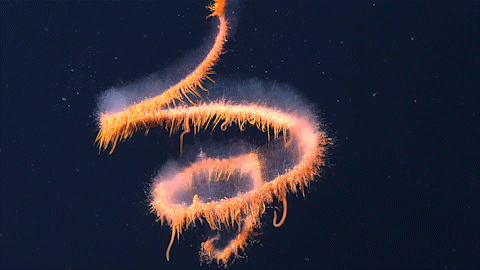28 February 2022

A siphonophore swimming through the water column. Full video is available on AGU’s YouTube channel. Credit: Monterey Bay Aquarium Research Institute.
AGU press contact:
Liza Lester, +1 (202) 777-7494, [email protected] (UTC-5 hours)
Contact information for the researchers:
Shirah Strock, Roger Williams University, [email protected] (UTC-5 hours)
WASHINGTON—New videos of fragile, spindly deep-sea creatures called physonect siphonophores reveal how their specialized jet-powered members propel their colonies through the world’s oceans. The findings could help reveal new information about these elusive creatures and inform designs of novel underwater vehicles.
Siphonophores are marine organisms, similar to jellyfish. They are long, thin colonies made up of dependent, specialized individual organisms that perform different functions, including some that move the colony around in the water.
Siphonophores propel themselves in a way similar to jellyfish, but instead of just one round bell that contracts to propel them through the water, a siphonophore has many smaller bells. The bells contract and jet out water in a wave-like pattern, like the legs of a centipede, to move the colony through the water.
But just how the siphonophores coordinate their movements isn’t well understood, said Shirah Strock, a student at Roger Williams University who, under the supervision of Associate Professor of Environmental Science Sean Colin, is studying video footage of wild siphonophore colonies collected in collaboration with the Monterey Bay Aquarium Research Institute. Strock will present the findings on 1 March at the 2022 Ocean Sciences Meeting, taking place online everywhere from 24 February to 4 March.
“Siphonophores, like other very delicate oceanic gelatinous zooplankton, are difficult to study so very little is known about their role in the oceanic ecosystem,” said Colin. “These types of studies can also help inform engineers who are interested in designing new novel underwater vehicles inspired by multi-jet animals.”
The videos were shot using high-resolution cameras mounted on small remotely operated vehicles (ROVs). The mini-ROVs allow the cameras to track and gently follow the siphonophores without disturbing them. In the wild, some siphonophore species are more than 50 meters long — longer than a blue whale — which makes their method of coordinated propulsion all the more intriguing and difficult to study.
“I’m trying to learn about their swimming patterns, how long they are contracting each bell and how long they wait between each contraction,” said Strock. Her analysis has focused on how long each bell contracts, how much time there is between pulses, and how often each bell pulses.
“These three variables help us understand things like thrust and give us a general idea about how the animal is swimming,” Strock said.
Previous researchers have studied lab specimens of siphonophores, but these studies are less useful because the creatures are in a confined space, Strock said. The video footage of siphonophore colonies in the wild allows for a more nuanced analysis of their movements.
Among the observations Strock will be presenting is how the bells of the same species contract their bells differently in videos taken off coast of Panama compared to videos shot in the cooler waters of Monterey Bay, California.
“One species in two different locations has different patterns,” Strock observed. She suspects it’s related to the different temperatures of the two locations.
# # #
More than 5,000 scientists are expected to present the latest research findings about the world’s oceans at the Ocean Sciences Meeting 2022. The biennial meeting brings together researchers from the American Geophysical Union, the Association for the Sciences of Limnology and Oceanography, and The Oceanography Society.
AGU (www.agu.org) supports 130,000 enthusiasts to experts worldwide in Earth and space sciences. Through broad and inclusive partnerships, we advance discovery and solution science that accelerate knowledge and create solutions that are ethical, unbiased and respectful of communities and their values. Our programs include serving as a scholarly publisher, convening virtual and in-person events and providing career support. We live our values in everything we do, such as our net zero energy renovated building in Washington, D.C. and our Ethics and Equity Center, which fosters a diverse and inclusive geoscience community to ensure responsible conduct.
Notes for Journalists
Shirah Strock will be available for interviews during the meeting. Please contact her via email: [email protected]
Session information: Session Block: PIP01 Physical-Biological Interactions Posters 1
Presentation abstract: Coordination of jet propulsion among physonect siphonophores
Videos related to this press release and this presentation are available on AGU’s YouTube channel, here.
For information about Ocean Sciences Meetings 2022, including the schedule of press events, visit the Ocean Sciences Meeting 2022 Media Center.
Neither the presentation nor this press release is under embargo.